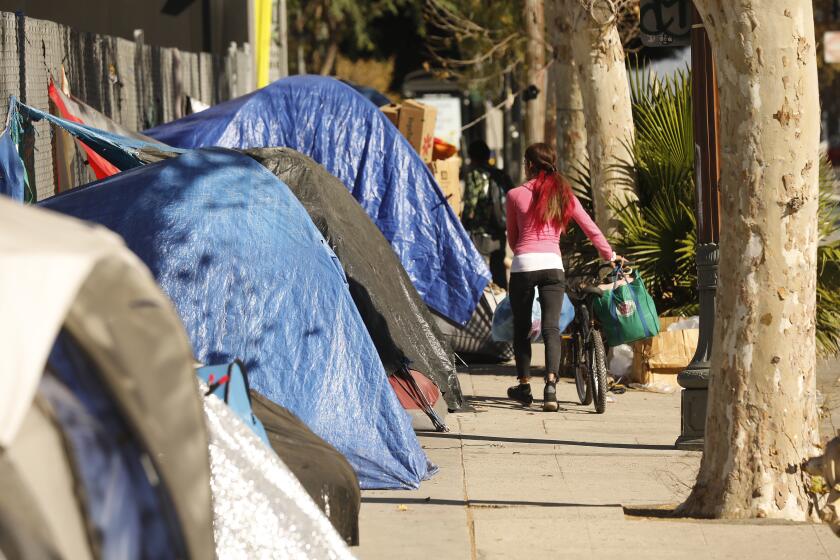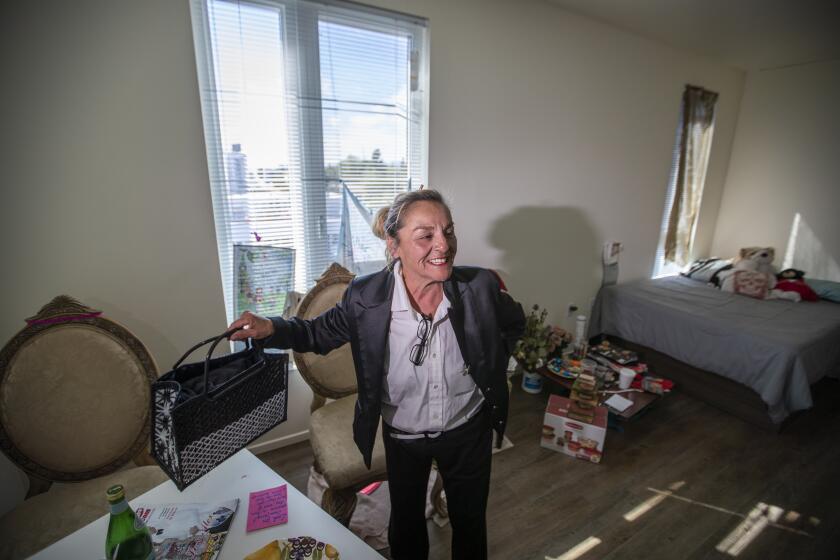L.A.’s homeless numbers are grim. We must keep building housing and expanding services

- Share via
Once again, the news from the annual tally of the Los Angeles County homeless population is grim. Based on the three-night point-in-time count conducted in January, the number of homeless people in Los Angeles rose by 10% to 46,260 this year from 41,980 in 2022. The overall number in Los Angeles County went up 9% to 75,518 from 69,144. The majority are unsheltered, living outside, often in tents or vehicles.
Especially alarming is the 18% jump from 2022 in the number of chronically homeless people in the county (excluding Pasadena, Long Beach and Glendale, which report separately.) These are the most vulnerable individuals in the homeless population — the ones who have been unhoused for at least a year and struggle with a mental health issue, a substance use disorder, a physical disability or a combination of these problems. The homeless population is also getting older, and that means chronically homeless people are probably struggling with age-related health conditions. Last year, there were an estimated 4,244 homeless adults 65 or older. This year there are about 4,725 in that age group.
What happened? The January 2022 homeless numbers increased a modest 4% from 2021 in the county, and barely at all in the city — perhaps a result of an infusion of COVID-era federal rental subsidies and evictions being put on hold during 2021.
Homeless numbers rose significantly less in the past two years. Experts say if we want them not to shoot up again, keep tenant protections in place.
L.A. County is not alone in seeing a rise in homelessness. The increases were even higher in other counties — 22% in San Diego County, 26% in San Bernardino County and 12% in Riverside County.
L.A. city and county governments have invested billions in building permanent housing, providing services to people with mental health and substance use issues and placing people in interim housing such as hotels, motels, tiny houses and group shelters. Yet those investments haven’t ended the crisis. That’s because several years of effort and money can’t begin to fix the underlying systemic problems that bedevil us — mainly the severe lack of affordable housing. Entrenched racism is also a factor; Black people make up 9% of the L.A. County population, but nearly 32% of the homeless population.
We need to create substantially more affordable and permanent supportive housing and expand homelessness prevention efforts so people won’t become homeless. The city has already been financing apartment buildings and rehabbing motels into housing and distributing housing vouchers for rental units. Some provider agencies have been master leasing apartment buildings. The Los Angeles Homeless Services Authority along with the county is looking into a master lease program.
The rise in the number of people experiencing chronic homelessness — now 32,000 in the county — may be the result of focusing on subsidies for rapidly rehousing people. Those subsidies are best for recently homeless people, not the more troubled chronically homeless individuals. Va Lecia Adams Kellum, the chief executive of Los Angeles Homeless Services Authority, told reporters at a briefing in June that it is somewhat easier to house the newly homeless than chronically homeless individuals, who take longer to engage. She said it may be time to shift some of that focus. “Maybe there are some things we need to be doing differently.”
Newly homeless people often fell out of housing mostly because they couldn’t afford the rent. A rental subsidy is often all they need to get housed and working again. A recent UC San Francisco study on homelessness in California revealed that many people fell into homelessness simply because they couldn’t afford their housing. A mere subsidy of between $300 and $500 a month for a sustained period would have staved off their homelessness, they told researchers.
Editorial: Homeless people shouldn’t spend weeks proving they’re poor before they get an apartment
Homeless people shouldn’t have to spend weeks collecting proof of their Social Security numbers and poverty before they can move into apartments.
Chronically homeless people need housing with services to help them cope with a mental illness or substance addiction or physical ailment and stay housed. Many have moved into the thousands of Proposition HHH-funded units of permanent supportive housing that have opened in the last couple of years. More will open this year, but there is still not enough of that kind of housing to help the people considered chronically homeless.
We have to do both: House chronically homeless people before their mental or physical health deteriorates further or they become reluctant to engage with outreach workers and help newly homeless people before they become chronically homeless.
Mayor Karen Bass, who took office in December, has done an admirable job of acting with urgency to address homelessness — cutting red tape on homeless housing projects and setting up Inside Safe, a program to move people off streets and into mostly motels and hotels as interim housing. Bass said last month that more than 14,000 homeless individuals had been moved off the streets during the first six months of her administration, about 1,300 of them as part of the Inside Safe initiative. About 4,300 people got permanent housing.
The 2023 homeless count didn’t reflect anything that Bass did or didn’t do as she just took office in December. But the rise in numbers should spur the mayor to continue to treat this as a crisis.
“It is fine to create temporary interventions, but without a permanent exit strategy all we are doing is creating a long-term alternative to the streets,” said John Maceri, chief executive of the People Concern, a service provider that works with many chronically homeless people.
Maceri is right. Bass has done a good job offering many homeless people temporary housing in motels and hotels. And a motel room is better than a tent on a street corner. But until a person has a permanent home, they are still homeless.
More to Read
A cure for the common opinion
Get thought-provoking perspectives with our weekly newsletter.
You may occasionally receive promotional content from the Los Angeles Times.











